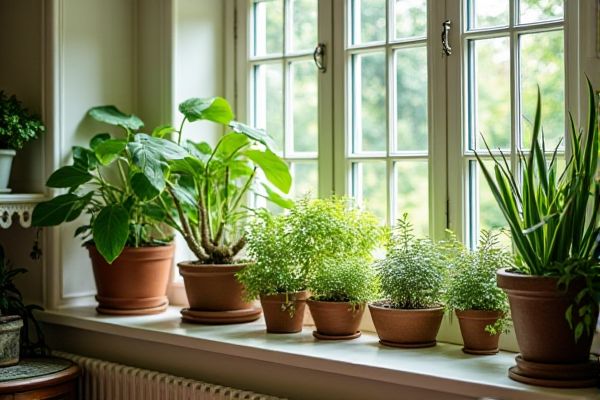
A plant stand offers versatile placement and better air circulation for your plants, while a window sill garden in a sunroom maximizes natural sunlight exposure, creating an ideal environment for growth. Explore the benefits of each option to decide which suits your space and gardening needs best.
Table of Comparison
| Feature | Plant Stand | Window Sill Garden (Sunroom) |
|---|---|---|
| Location | Indoor or outdoor, flexible placement | Indoor, fixed by window with natural sunlight |
| Space Efficiency | Vertical space-saving, multi-tier options | Limited to window sill length and depth |
| Light Exposure | Dependent on placement, can be adjusted | Maximized natural sunlight from window |
| Design & Style | Varied materials and styles, decorative | Minimalist, integrated with window area |
| Plant Types | Suitable for medium to large pots, climbing plants | Ideal for small pots, herbs, succulents |
| Mobility | Portable and easy to move | Fixed, not portable |
| Maintenance | Requires manual watering and sun management | Plants get natural light; same watering needs |
| Cost | Varies: affordable to premium models | Generally low cost, uses existing window space |
Introduction to Indoor Gardening: Plant Stand vs Window Sill Garden
Indoor gardening offers versatile options such as plant stands and window sill gardens, each maximizing natural light for healthy plant growth. Plant stands provide multi-tiered space, allowing you to organize a variety of plants vertically and enhance airflow. Window sill gardens utilize limited space by placing plants close to sunlight, ideal for herbs and small pots within your sunroom.
Space Efficiency: Maximizing Your Indoor Garden Area
Plant stands offer vertical space utilization, allowing multiple plants to be arranged compactly, which maximizes indoor garden area without occupying excessive floor space. Window sill gardens in sunrooms leverage natural sunlight and often fit seamlessly into narrow ledges, efficiently using limited horizontal space for smaller pots and herbs. Combining both methods optimizes space efficiency by layering plants at various heights while capitalizing on available light sources.
Light Requirements: Accessing Natural Sunlight in Sunrooms and Sills
Plant stands in sunrooms offer the flexibility to position multiple plants at varying heights, maximizing exposure to natural sunlight through large windows and ensuring optimal photosynthesis. Window sill gardens benefit from direct, consistent sunlight but are limited by space and sunlight angles, often favoring smaller or sun-loving plants such as succulents and herbs. Understanding the light intensity and duration on specific sunroom windows versus sill locations is crucial for selecting plants that thrive under those natural sunlight conditions.
Plant Variety: Choosing the Right Plants for Each Setup
Plant stands offer greater flexibility for a diverse plant variety, accommodating larger pots and varying heights, ideal for tropical and bushy plants that need ample space. Window sill gardens in sunrooms are best suited for smaller, sun-loving plants like succulents, herbs, and compact flowering species that thrive in confined areas with direct sunlight. Your choice depends on the plant types you want to cultivate and the spatial conditions each setup provides for optimal growth.
Aesthetic Appeal: Styling Your Indoor Garden Space
Choosing a plant stand offers versatile height options and a dynamic way to showcase various plants, creating a layered and visually engaging indoor garden space. A window sill garden maximizes natural light exposure and provides a minimalist, compact aesthetic that enhances the sunroom's brightness and openness. Your styling choice depends on whether you prefer a structured display or a cozy, sunlit arrangement that blends seamlessly with the window frame.
Mobility and Flexibility: Rearranging Plants for Growth
Plant stands offer superior mobility and flexibility, allowing you to easily rearrange plants to optimize sunlight exposure and promote healthier growth. Unlike window sill gardens, which are fixed in place and limited by the sill's dimensions, plant stands can be relocated to different areas within your sunroom or home as light conditions change throughout the day or seasons. This adaptability ensures your plants receive the ideal environment for thriving growth and effortless care.
Maintenance and Watering Convenience
Plant stands offer easier maintenance and watering convenience due to their elevated design, allowing for better air circulation and quick drainage. Window sill gardens in sunrooms often require careful monitoring to avoid water accumulation that can damage the sill or promote mold growth. Regularly scheduled watering on plant stands minimizes mess and supports healthier plant roots, while window sill setups demand attentive care to balance sunlight exposure and moisture levels.
Cost Comparison: Investment and Upkeep
Plant stands generally require a moderate initial investment with prices ranging from $20 to $150 depending on materials and design, while window sill gardens often cost less upfront, primarily involving pots and soil within a $10 to $50 range. Maintenance expenses for plant stands may be higher if decorative elements or additional lighting are used, whereas window sill gardens usually involve minimal upkeep, focusing on regular watering and occasional fertilizing. Your choice impacts ongoing costs, with plant stands potentially incurring more for durability and aesthetics, while window sill gardens offer a budget-friendly option for sunroom gardening.
Climate Control: Temperature and Humidity Factors
Plant stands in sunrooms offer better climate control by elevating plants for improved air circulation, which helps regulate temperature and humidity around each plant individually. Window sill gardens often experience fluctuating temperature and humidity levels due to direct exposure to sunlight and drafts from windows, potentially stressing sensitive plants. Optimal temperature for most sunroom plants ranges from 65-75degF with humidity levels between 40-60%, conditions more consistently maintained with the use of adjustable plant stands.
Conclusion: Which Indoor Gardening Method Suits You Best?
Choosing between a plant stand and a window sill garden in a sunroom depends on space availability, light requirements, and plant variety. Plant stands provide vertical space for multiple plants and better air circulation, ideal for larger collections or decorative displays. Window sill gardens maximize natural sunlight for herbs and small plants, perfect for limited space and easy access to sunlight in compact sunrooms.
 homyna.com
homyna.com